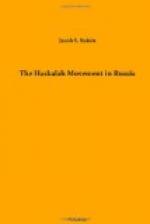Thus began the bitter fight against Haskalah, in which Hasidim and Mitnaggedim, forgetting their differences, joined hands, and stood shoulder to shoulder. For, after all, was not Judaism in both these phases endangered by the new and aggressive enemy from the West? And did not the two have enough in common to become one in the hour of great need? Hasidism, in fact, was Judaism emotionalized, and since, beginning with Rabbi Shneor Zalman of Ladi, it, too, advocated the study of the Talmud, the distinction between it and Mitnaggedism was hardly perceptible. The study of the Zohar and Cabbala was equally cultivated by both; Isaac Luria and Hayyim Vital were equally venerated by both, and hero worship was common to both. The Ascension of Elijah (Gaon) is as full of miracles as The Praises of the Besht. It is no wonder, then, that the animosities, which reached their acme during the last few years of the Gaon’s life, were weakened after his death, and that the compromise, pleaded for by Doctor Hurwitz and Manasseh Ilye, was somehow effected. But it was otherwise with the Haskalah. “Verily,” says the zaddik Menahem Mendel of Vitebsk, “verily, grammar is useful; that our great ones indulged in the study thereof I also know; but what is to be done since the wicked and sinful have taken possession of it?” In the same manner does Rabbi Hayyim of Volozhin inveigh against the followers of Mendelssohn, because of the latitudinarian habits of the Maskilim, who “despise the counsel of their betters, and go after the dictates of their hearts."[35] Both saw in Haskalah a deadly foe to their dearest ideals, a blight upon their most cherished hopes, and, like Elizabeta Petrovna, they would not derive even a benefit from the enemies of their religion.




